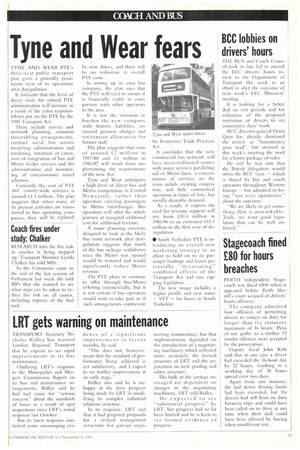Tyne and Wear fears
Page 21

If you've noticed an error in this article please click here to report it so we can fix it.
TYNE AND WEAR PTE's three-year public transport plan gives a generally pessimistic view of its operations after deregulation.
It forecasts that the level of direct costs for central PTE administration will increase as a result of the extra responsibilities put on the PTE by the 1985 Transport Act.
-these include service and network planning, common timetabling arrangements. contract social bus service tendering administration and tendering, retention Or extension of integration of bus and Metro feeder services and the administration and monitoring of concessionary travel schemes.
Currently The cost of PTE and county-wide services is around ti4.3 million. The plan suggests that when many of its present activities are transferred to bus operating companies, they will he replaced by new duties, iind there will be no reduction in overall costs.
In setting up its own bus company, the plan says that die PIE will need to ensure it is financially viable in comparison with other operators in the area.
It is not the intention to burden the new company with historic liabilities, increased pension charges and retirement allowances for former staff.
The plan suggests that costs of around ti2 million in 1987/88 and til million in 1986/87 will result from implementing the requirenwnts of the new Act.
Tyne and Wear anticipates a high level of direct bus and Metro competition in Central New-castle, rather than operators carrying passengers to Metro interchanges. Bus operators will offer the whole journey at marginal additional cost for additional revenue.
A route planning excercise designed to look at the likely bus route network after deregulation suggests that much of the bus mileage withdrawn since the Metro was opened would he restored and would significantly reduce Metro revenue.
The PTE plans to ccmtinue to offer through bus/Metro ticketing commercially, but it is not certain if bus operators would wish to take part or if such arrangements contravene Tyne and Wear ander threat.
the Restrictive Trade Practices Act.
It concludes that the new commercial bus network \yin have unco-ordinated routes with many services paralleling rail or Metro lines, a concentration of services on the main radials creating congestion, and little commercial operation at times of low, hut socially desirable demand.
As a result, it expects the need for revenue support will rise from ti30.4 million in 1985/86 to an estimated ti-1-3.1 million in the first year of deregulation.
• South Yorkshire PTE is introducing an overall new marketing strategy in an effort to hold on to its passenger loadings and lessen potentially "devastatingcombined effects of the Transport Act and rate capping legislation.
The new image includes a higher profile and new name SYT for buses in South Yorkshire












































































































































